EXAMPLE OF ZINES;




MOODBOARD:

WHAT IS A ZINE:
A zine (pronounced zeen) is an independently or self-published booklet, often created by physically cutting and gluing text and images together onto a master flat for photocopying, but it is also common to produce the master by typing and formatting pages on a computer. The publication is usually folded and stapled.
Historically, zines have been around since 1776 when Thomas Paine self-published Common Sense and used it as an instrument in promoting the ideas that contributed to the U.S. War for Independence. Just a perfect example to demonstrate the free spirit of zine culture. Format, size and orientation.
Zine comes from fanzine which is a term that generally describes a small-circulation science fiction publication. Fanzines first appeared in the late 1920s.
Zines were used to promote punk music in the 1970s, a time when this type of music received very little interest from the larger press music. This phenomenon spawned a new interest in self-publishing.
There are many bold, funny and beautifully designed zines out there.
Some zines became so popular and turned into regular publications, such as B****.

